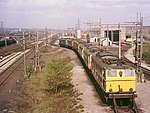Wath upon Dearne
Geography of the Metropolitan Borough of RotherhamPages with no open date in Infobox stationTowns in South YorkshireUnparished areas in South YorkshireUse British English from June 2016 ... and 1 more
Wath upon Dearne

Wath upon Dearne (shortened to Wath or often hyphenated) is a town south of the River Dearne in the Metropolitan Borough of Rotherham, South Yorkshire, England, 5 miles (8 km) north of Rotherham and almost midway between Barnsley and Doncaster. It had a population of 11,816 at the 2011 census. It is twinned with Saint-Jean-de-Bournay in France.
Excerpt from the Wikipedia article Wath upon Dearne (License: CC BY-SA 3.0, Authors, Images).Wath upon Dearne
High Street,
Geographical coordinates (GPS) Address Nearby Places Show on map
Geographical coordinates (GPS)
| Latitude | Longitude |
|---|---|
| N 53.5022 ° | E -1.3402 ° |
Address
High Street
High Street
S63 7PU
England, United Kingdom
Open on Google Maps







